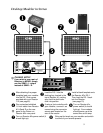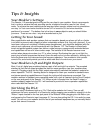13
Downloading Custom Tones:
The Reactor 112 was designed to bring out the very best in your modeler. That means the one
you own. As the Reactor has become the industry standard for taking modeling tools live some
manufacturers have expressed interest in developing presets for their modelers that are Reactor
specific. Since the DS-1 and the Reactor were designed as a “platform” for different types and
brands of modelers we welcome these efforts to improve your playing experience. Some times
it’s great to have a jumping off point. With this in mind Atomic has gotten together with some of
our industry friends and put together some of our own sound patches. So, check out the Custom
Patches section on our web-site at atomicamps.com. There you will find downloadable custom
Reactor tone patches for all of the most popular modelers and programmable guitar preamps.
Reactors used with Analog Preamps
Variety is the spice of life. That’s why we made the Reactor 112 the perfect platform for all kinds
of guitar amp front ends. Go ahead, experiment, take that TriAxis or Kolbe GP-1 and plug its line
output right into the return input on the rear panel of the Reactor you might be in for a pleasant
surprise!
Using a Microphone vs. Going Direct
At Atomic we feel that this should be up to the player or engineer to decide. Running direct gets
rid of stage bleed and microphone coloration, BUT if you mic the Reactor 112 it sounds an awful
lot like you are micing whatever amp your modeler is set to. This makes the Reactor an excellent
choice for recording studios.
Using Effects Pedals etc.
Many players blend stomp boxes and effects processors from various brands and vintages to
shape their own unique sound and are not ready to give them up for the all in one solution
offered by modelers (as convenient and tempting as it may be). The Reactor 112 works great
with all outboard gear – analog, digital and otherwise! In cases where a modeler is loaded in the
DS-1, use the Reactor as you would any combo amp with an effects loop to position outboard
gear both before and after the preamp (modeler). The Reactor works equally well with floor
based and pro rack modelers. In this instance there is no need to use the effects loop in the
traditional sense since you can insert effects between the modeler and the Reactor’s power
section by putting them after the modeler’s output and before entering the Reactor via the Return
jack. This achieves the same result. As always, consult your effects processor’s manual for
guidelines for proper operation.
Running Stereo
The recommended “norm” for stereo playback in recording and mastering studios as well as
pretty much all listening environments is that the left and right speakers be placed in an
equilateral triangle in conjunction with the listener’s ears. This type of listening / playing set up
takes into consideration things like phase coherency, spatial imaging, and let’s not forget effects
like auto-pan, stereo flanging and Ping-Pong echo. Stereo is great fun to listen to and even more
fun to play through. The sonic “space” that one can create can lead to inspiration, which you just
can’t hang a price tag on. So …Unless you plan on sticking your face directly in front of one of
those all in one stereo cabinets you do the math. 2 Reactors on the other hand allow you to
create a TRUE stereo spread.


















